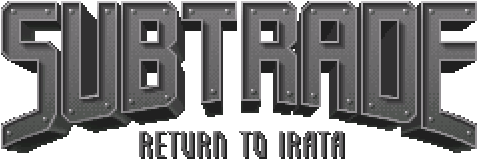|
This page provides a review comparing the seminal video game M.U.L.E. with its clone Subtrade. Apart from anybody looking for a good game, it is addressed to all those who know the original and would like to find more M.U.L.E.-related experiences. You might want to read this page and then, maybe, have a shot at Subtrade.
The original MULE
|
In 1983, Electronic Arts released one of its first successful computer games: M.U.L.E., a funny multi-player economic strategy game developed by the "Ozark Softscape", a 4-person team from Arkansas. M.U.L.E. is a landmark in computer game history. You can read about it on several websites and occasionally even in present-day magazines. There are still thousands of fans around the world playing it on a regular basis.
The basic appeal of M.U.L.E. lies within its apparent simplicity still providing a rather interwoven gameplay. And M.U.L.E. is one of the first social computer games. The fun side turns up most when you play it with 4 human players. Nonetheless, you can still have a lot of fun with less human players or even against the computer only.
Originally, M.U.L.E. was made to run on Atari and Commodore 8-bit-computers. Nowadays, it is primarily played through emulators on modern PCs. Recently, you can even play it against other players over the internet by using the Kaillera-interface. In other words, M.U.L.E. still has a vital community despite its age.
|
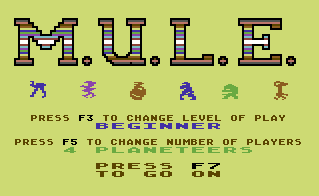
Title screen of M.U.L.E. |
Subtrade
|
Even though I really praise the original M.U.L.E. (keeping a genuine copy of it in my display cabinet), I tend to like one of its clones a wee bit more: Subtrade. Subtrade is a discreetly enhanced version of the game and was released ten years after M.U.L.E. in 1993 for the Amiga computer and later for MS-DOS.
The game takes advantage of the graphical and audio capabilities of 16-bit-computers of that time, therefore providing a rather advanced look-and-feel as compared to the original game.
The gameplay of Subtrade is very close to that of M.U.L.E. In fact, it feels so much like it that my friends and I tend to use the original terminology when playing or talking about it. However, Subtrade is not M.U.L.E. There are several notable differences.
|
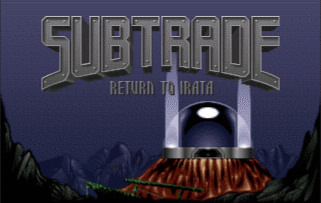
Title screen of Subtrade
|
Differences between M.U.L.E. and Subtrade
The background story
Unlike M.U.L.E., Subtrade presents a dramatic and slightly apocalyptic background story about four castaways grounding on a remote planet. The result, though, is the same as in M.U.L.E.: 4 players start to build a colony on the planet Irata. Only that Irata has meanwhile turned from a desert planet into an oceanic one. Personally, I figure, somebody must have left the terraforming appliance turned up too high when the guys from M.U.L.E. left. Anyway, for the actual game, the story is completely marginal.
The terminology
Due to the oceanic setting, some commodities are renamed in Subtrade: Food is now Fish, Crystite is now Pearls, Smithore becomes just Ore. Energy remains energy. Instead of MULEs, Subtrade uses turtles as multi usage labor elements; they have the same characteristics as MULEs, though. Finally, the mountain wampus of M.U.L.E. has mutated into a fish called Wanda.
Differences in the gameplay
As mentioned above, the gameplay is almost the same as in M.U.L.E. The only thing new is the possibility to directly build turtles (MULEs) on coral reefs for your own usage. These "private" turtles cannot immediately be bought by the other players. You may, however, sell them to the public store where the others can get them. This is a nice twist in the gameplay as it provides a better option for holding back ore to drive prices up.
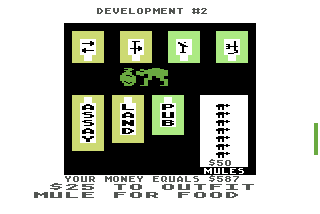 |
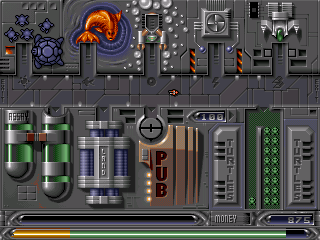 |
| The store of M.U.L.E. |
The store of Subtrade
(note the private corral with a turtle) |
Computer players
Now this is where Subtrade really beats M.U.L.E.: The computer players are very aggressive and use every chance to let you run dry on vital supplies. Once they have you worn, do not expect any mercy of them. They also follow long term strategies to manipulate prices. Last but not least, the computers try to catch Wanda (the Wampus) and mostly get her.
The game balance
This is a very complex point and difficult to assess. Subtrade seems to evaluate production, needs and prices in a slightly different manner than M.U.L.E. In general, the market seems more dynamic and more susceptible to player's action. For example, prices for commodities (fish and energy) are based only on the stock of the store and not, as in M.U.L.E., to some extent on the reserve of the entire colony. This way, single players can more easily drive prices in one or the other direction. Further, the commodities are needed in higher quantities making them more valuable. Summarized, the players have more individual influence on the market, and the "right" strategy is less foreseeable.
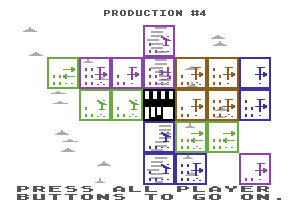 |
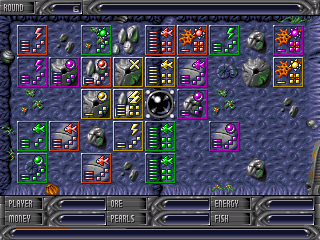 |
| The colony on Irata (M.U.L.E.) |
The colony on Irata (Subtrade) |
Messages
M.U.L.E.'s original message texts have been adapted to the sub-oceanic context. Generally, they have the same effects as those of M.U.L.E. Some messages are new and, I admit, a few of them have not revealed their effect to my perception. A notable difference to M.U.L.E. is that events occur in a more random way. For instance, you cannot count on receiving a package from home when you completely run out of fish and energy for the first time. Also unlike M.U.L.E., it is not more likely that the best player gets the bad messages and vice versa.
Game options
Subtrade provides a possibility to choose a bonus on any of the trade items or money for any chosen character (species) at the start of the game. In M.U.L.E., you can only choose a few species that have a monetary bonus or malus at start. On the other hand, Subtrade does not offer a beginner or intermediate difficulty level of the game. All games are played at full complexity and for 12 rounds. Further, there is no demo mode available in Subtrade.
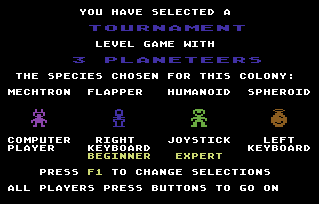 |
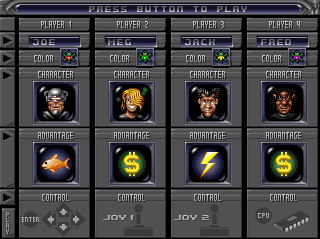 |
| Option screen of M.U.L.E. |
Option screen of Subtrade |
The user interface
The user interface looks a little more stylish than that of M.U.L.E. but the functionality is (almost) the same. A nice gain is that auctions automatically stop when there is nothing left to trade. This significantly speeds up the game. In M.U.L.E., all auctions run for the full time unless there is already nothing to trade in the beginning.
Why you should play Subtrade instead of M.U.L.E.
There are a few reasons why you should try Subtrade:
- Subtrade is played faster (often little more than 1 hour for all 12 months).
- The computer players pose more of a challenge.
- You have one more twist in the gameplay (direct production of turtles).
- You get more variety in the behaviour of the market.
- Subtrade has better graphics and sound.
- You like underwater worlds more than deserts.
When you should NOT play Subtrade instead of M.U.L.E.
There are also a few reasons for sticking to the original M.U.L.E.:
- You need to play over the internet with 4 players at 4 different locations. (The Kaillera-client for the Amiga-platform supports 2 remote joysticks only. There is no remote play for MS-DOS. You would need the Atari800WinPlus-emulator and the Atari version of M.U.L.E. for 4 players to play at 4 different locations.)
- You are beginner and need an easy introduction.
- You are a slow player.
- You don't have the time to play more than 6 rounds (months).
- You want to be reminded exactly to your old times.
- You insist that Irata is a desert planet and the constitutive color of it is white.
The versions of Subtrade
There are two versions of Subtrade available: One for the Amiga and one for MS-DOS. The gameplay of both versions is basically identical (the only difference is a second fish in the MS-DOS version that cost you a fine if you catch him instead of Wanda). There is a little difference in graphics, sound and the user interface.
The Amiga version
|
The Amiga version uses good quality 8-bit digital sound and has an atmospheric music for the intro and a snappy theme for the title screen. There is no background music during the game. Action sounds are short and to the point.
The display of this version uses a 320x256 pixel resolution with 32 colors.
The game can be played with 4 players, either with 2 joysticks or, through a parallel port interface, with 4 joysticks. The game cannot be played without any joystick, a second and a third player can use the keyboard, though, and share an available joystick for the movement phase. |
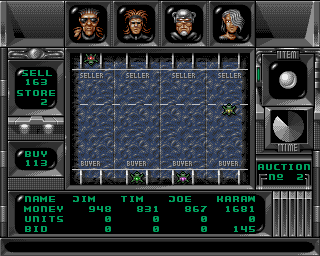
Amiga-version |
The MS-DOS version
|
The MS-DOS version uses predominantly the midi synthesizer and some high quality 16-bit samples. The musical score is very different to that of the Amiga version. The introduction music and the title music are both very rhythmic and sound like an 80's synthesizer piece with techno beat. There is a low midi background tune during most of the game. Action sounds are midi generated and rather playful.
The display of this version uses a 320x240 pixel resolution with 128 colors. There are a few additional but nonrelevant details in the graphics, like a funny squid observing the auctions and some small water drops.
The game can be played with 4 players and a maximum of 2 joysticks. It is possible to play it without any joystick. |
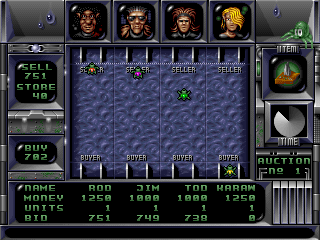
MS-DOS version |
Personal comment
I have tried to make a case for Subtrade here because I think the game is a lost gem and will give you a lot of fun playing it. I am in no way related to any of the producers nor do I have an economic interest in the product.
Please, feel free to contact me on an any matter concerning this page at: kaufer at coralnet dot de. Put "subtrade" into the subject to avoid my spam filter.
Karawane
FAQs
If Subtrade was so good, why has it not been a great success back in 1993?
I guess, there are two reasons for that. First: Those days, many fans of M.U.L.E. were hoping for the licensed successor "Deluxe MULE" to come out. Subtrade was just an unlicensed clone, thus, not the real thing. Second, the marketing strategy and game interface were aimed at the 16-bit home-computer platforms. But Commodore (and also Atari) went broke that year. The DOS-Version came out a year later, but this platform was just not a market for joystick-games with 4 players.
Which version do you recommend for playing Subtrade on a modern PC?
On todays PCs, you need an emulator for either version. If you don't have any idea use the MS-DOS version. The graphics are slightly smoother due to the extended palette, the emulators (e.g. DOSBox) are easier to setup, and you don't necessarily need a joystick for playing. Nonetheless, some people prefer the Amiga version for the following reasons: The style of the in-game sounds is somehow closer to that of M.U.L.E. Further, with the Amiga version, there is no need to use the keyboard, thus allowing all four players to lean back with their joysticks on the sofa - just like Atari-M.U.L.E. Note also that the only way to play Subtrade via Internet (with 4 players at two different locations) is through the Amiga version and WinUAE (Kaillera version).
Do you only play Subtrade or do you still play the original M.U.L.E.?
In fact, I play the original M.U.L.E. more often because we need the Kaillera-Client with 4-joystick support (4 players at 4 different locations). But any time we get together personally, I insist on Subtrade. It's just more fun and a nice change.
|
|
